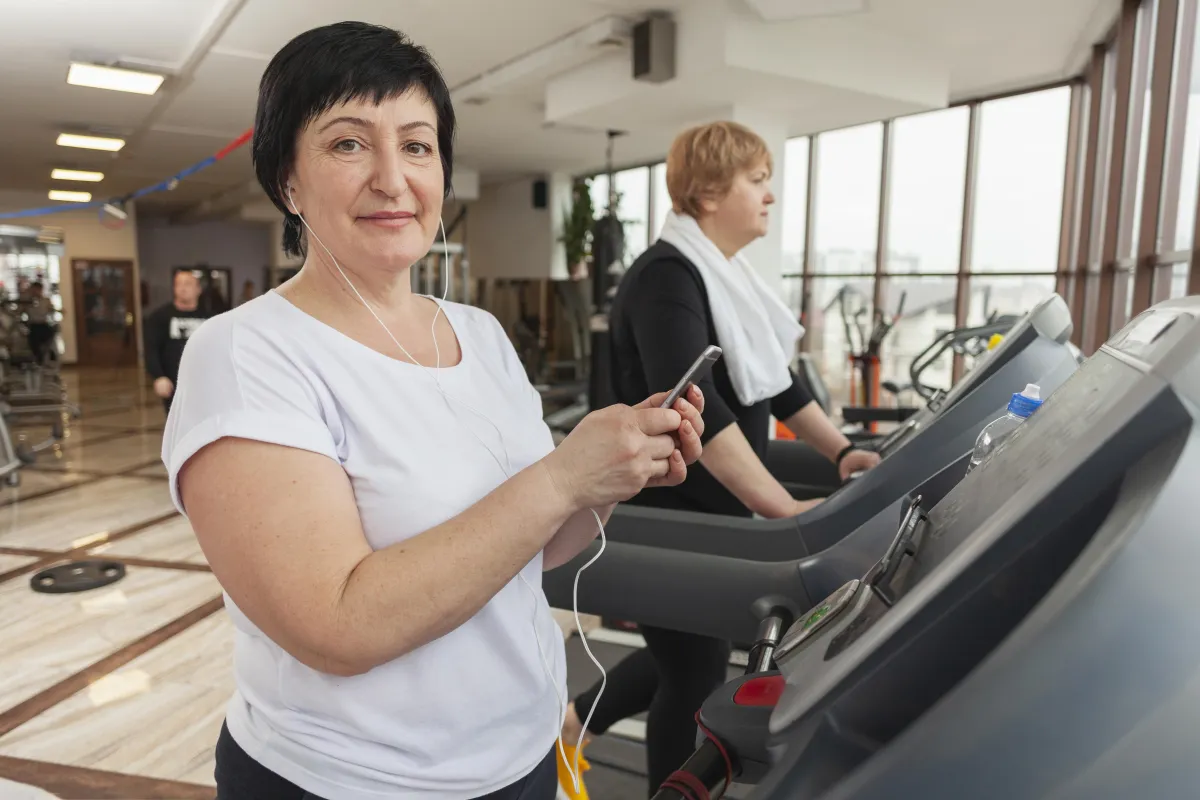
How to Build Healthy Bones With a Bone Gym
What Is a Bone Gym? Your Complete Guide to OsteoStrong
You're probably used to gyms being all about treadmills, bench presses, and heavy lifting. A bone gym is different. They are designed to support your skeletal health through short and effective programs that help you build bone density, reduce joint pain, and become stronger overall.
Bone gyms like OsteoStrong use osteogenic loading technology to safely stimulate bone and muscle growth, making it a game-changer for people seeking better bone health. Even for people diagnosed with bone-related issues like osteopenia and osteoporosis, bone gyms are the best bet for managing them.
If you're a woman over 40, an elderly individual, or simply curious about building stronger bones, this article will demystify bone gyms and explain how they work. Find out why the Upper West Side's health-conscious residents are embracing this innovative fitness solution.
Jump to Section
What Exactly is a Bone Gym?
How Bone Gyms Work: The OsteoStrong Procedure Explained
OsteoStrong: The Pioneer of Bone Gym Technology
Differences Between Bone Gyms and Traditional Gyms
Who Benefits Most from Bone Gyms?
Other Benefits of Using OsteoStrong
10-Minute Workout Sessions Per Week
Real Results From Our Members
What to Expect: Your First Bone Gym Experience
Frequently Asked Questions
What Exactly is a Bone Gym?
A bone gym is a specialized fitness facility designed to improve skeletal strength. They are gyms exclusively for bone density and joint health.
Unlike traditional gyms that emphasize cardiovascular endurance or muscle building, bone gyms focus on applying controlled, high-intensity pressure to the bones to strengthen them. This concept is backed by the science of Wolff's Law, which states that bones naturally adapt to the stress placed on them.
The idea for bone gyms started in the early 2000s, when researchers and health innovators began exploring targeted ways to combat bone diseases beyond medication.
How Bone Gyms Work: The OsteoStrong Procedure Explained
The foundation of a bone gym lies in a process called osteogenic loading—a technique that applies controlled, high-intensity forces to the skeleton. Using the principle of axial compression, the equipment safely emulates the type of impact forces you might experience while sprinting or jumping, but without the risk of injury. These forces activate osteoblasts, the bone-building cells responsible for increasing bone density and strength.
At a bone gym like OsteoStrong, for instance, robotic precision equipment is used for brief, consistent workouts. These devices incorporate advanced safety mechanisms and real-time biofeedback systems, allowing members to see and track their progress instantly, making each session safe, personalized, and highly effective. Unlike free weights or traditional machines, bone gym sessions typically last just 10 minutes per week and still get the job done.
OsteoStrong: The Pioneer of Bone Gym Technology
OsteoStrong is the world's first and leading facility to specialize in skeletal strength conditioning.
What makes OsteoStrong unique is its use of proprietary robotic musculoskeletal treatment devices designed to apply safe, precise, high-intensity loads to the body. Members rotate through four specialized machines, each targeting a key area:
Upper body push/pull for arms, chest, and back strength
Core and pelvic floor exercises to improve stability and balance
Lower body loading for hips, legs, and knees
Postural exercises to reinforce spine alignment and reduce joint stress
People who use OsteoStrong reported a 10.7% increase in bone density within six months. Multiple clinical trials, particularly among postmenopausal women, have demonstrated significant improvements in bone mineral density, balance, and fall prevention.
OsteoStrong also operates under rigorous safety protocols, and while it is not classified as a medical device by the FDA, our technology is designed with medical-grade precision.

Differences Between Bone Gyms and Traditional Gyms
Traditional exercise is valuable, but it isn’t always enough to prevent bone loss. While both bone gyms and traditional gyms aim to improve health, their methods, time requirements, and outcomes differ significantly.
Below are a few core differences between traditional and bone gyms.
Time Commitment: The most apparent difference is efficiency. A bone gym session, although highly effective, lasts only 10 minutes once a week, making it a suitable option for busy individuals. Traditional gyms generally require 3–5 hours of weekly exercise.
Exercise Type and Intensity: Bone gyms utilize brief, high-intensity osteogenic loading to stimulate bone growth and development safely. Conventional gyms emphasize cardio, resistance training, and flexibility work, which are excellent for heart health and muscle development, but don't provide the same skeletal benefits.
Accessibility and Safety: A bone gym is designed for all ages and fitness levels, with advanced equipment that minimizes injury risks, offering a safer traditional gym alternative in Manhattan's Upper West Side.
Who Benefits Most from Bone Gyms?
Postmenopausal women (40+): Hormonal changes accelerate bone loss. OsteoStrong helps slow postmenopausal bone loss and reduce the risk of fractures.
Elderly males: Supports age-related bone density management and helps maintain independence as bones naturally weaken with age.
Athletes: Improves performance, strengthens joints and connective tissues, and reduces the risk of sports-related injuries.
Individuals with osteoporosis or osteopenia: Offers a safe, non-invasive approach to bone health management as part of ongoing medical care.
Individuals with lower back pain, joint & mobility issues: Enhances posture, improves skeletal support, and relieves stress on the spine.
Health-conscious professionals – Seeking efficient, science-backed fitness solutions.
Active aging population: Prioritizing long-term independence and strength.
Time-constrained individuals: Busy people benefiting from the 10-minute weekly workout model.
Other Benefits of Using OsteoStrong
A bone gym like OsteoStrong goes beyond osteogenic loading to offer a suite of services supporting whole-body wellness.
As a member of OsteoStrong, you get to enjoy more extensive benefits.
Advanced Bone Testing: REMS Scan Technology
OsteoStrong provides access to the REMS scan (Radiofrequency Echographic Multi Spectrometry), a cutting-edge, radiation-free bone scan. Unlike DEXA, REMS is portable, safe for repeated use, and provides a deeper analysis of both bone mineral density and micro-architecture.
It can also deliver a five-year fracture risk prediction, with results available in minutes rather than weeks. This makes it ideal for frequent monitoring of bone health and tracking treatment progress.
Nutritional Counseling
Diet plays a crucial role in skeletal strength. As a member of Osteostrong, you will receive guidance on bone-supporting nutrition, including calcium, vitamin D, and essential mineral optimization. Our nutritional experts also offer customized meal plans and recommend supplements to improve bone density further.
Red Light Therapy Integration
OsteoStrong integrates red light therapy, known for stimulating cellular regeneration, reducing pain and inflammation, accelerating recovery, and even supporting skin health.
Community and Support
Beyond treatments, OsteoStrong fosters connection through group wellness programs, educational workshops, peer support, and progress celebrations. You’re not alone. Members help one another stay motivated and empowered in their journey to improve their bone health.
10-Minute Workout Sessions Per Week
No need to break your back or sweat for hours. A full weekly OseteoStrong session lasts approximately 10 minutes, providing optimal stimulus for bone formation. Research shows this short timeframe is long enough to activate bone-building cells, but brief enough to avoid fatigue and overloading. The built-in recovery period between sessions allows the body to adapt and strengthen, following natural neurological adaptation principles.
Instead of demanding hours of training, OsteoStrong emphasizes consistency over duration. A simple weekly session makes it easier to stick with long-term, lowering barriers for busy professionals, older adults, or anyone managing health challenges.
What to Expect: Your First Bone Gym Experience
Your journey at a bone gym like OsteoStrong begins with an initial consultation to help you develop personal targets. A specialist will review your health history, conduct baseline measurements, and sometimes recommend a radiation-free REMS scan. You'll also get an orientation to the equipment and how each machine supports different areas of bone strength.
During your first session, expect a safety briefing and demonstrations of the four machines. Your trainer will set personalized loading targets and walk you through each exercise step by step. Finally, a progress tracking system is set up so you can monitor results from the very beginning.
Find your personalized bone-building plan. Book your consultation with OsteoStrong UW
Frequently Asked Questions
Is OsteoStrong safe for people with osteoporosis?
Yes, OsteoStrong is specifically designed for individuals with bone health concerns. The controlled loading environment provides safety mechanisms that traditional high-impact exercises cannot offer.
How does 10 minutes compare to hours at a traditional gym?
The high-intensity osteogenic loading in 10 minutes provides targeted bone stimulation that hours of traditional exercise may not achieve. However, both serve different health purposes.
What's the difference between REMS and DEXA scans?
REMS scans are radiation-free, provide more detailed bone architecture analysis, and offer 5-year fracture risk predictions, while DEXA scans use X-rays and focus primarily on density measurements.
How quickly will I see results?
Strength improvements typically occur within 4-6 weeks, while bone density changes require 6-12 months of consistent sessions for measurable improvements.
Can I combine OsteoStrong with my regular gym routine?
Absolutely. OsteoStrong complements traditional fitness routines by specifically targeting bone health in ways conventional exercise cannot.
At OsteoStrong UW, our team will conduct bone density tests to evaluate your bone quality and provide targeted programs and nutritional guidance to help improve your bone health. As always, consult your doctor to determine the best practices for your individual needs.
📞 Contact us at +1 914-690-7190
🌐 Visit us at https://osteonewyork.com/
📧 Email us at [email protected]


